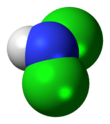Dichloramine
| |||
| Identifiers | |||
|---|---|---|---|
3D model (JSmol)
|
|||
| ChemSpider | |||
PubChem CID
|
|||
| UNII | |||
CompTox Dashboard (EPA)
|
|||
| |||
| |||
| Properties | |||
| Cl2HN | |||
| Molar mass | 85.92 g·mol−1 | ||
| Appearance | yellow gas[1] | ||
Except where otherwise noted, data are given for materials in their standard state (at 25 °C [77 °F], 100 kPa).
| |||
Dichloramine is a reactive inorganic compound. It has the formula Template:NitrogenTemplate:HydrogenTemplate:Chlorine. The yellow gas is unstable and reacts with many materials.[1] It is formed by a reaction between ammonia and chlorine or sodium hypochlorite. It is a byproduct formed during the synthesis of chloramine and nitrogen trichloride.
Synthesis
Dichloramine can be prepared by a reaction between chloramine and chlorine or sodium hypochlorite:[1]
Reaction
Dichloramine reacts with hydroxyl ion, which can be present in water or comes from water molecules, to yield nitroxyl radical and the chloride ion.[2]
References
- ^ a b c Holleman-Wiberg: Lehrbuch der Anorganischen Chemie, 102. Auflage, Berlin 2007, ISBN 978-3-11-017770-1.
- ^ White, George Clifford (1986). The handbook of chlorination (2nd ed.). New York: Van Nostrand Reinhold. p. 169. ISBN 0-442-29285-6.



